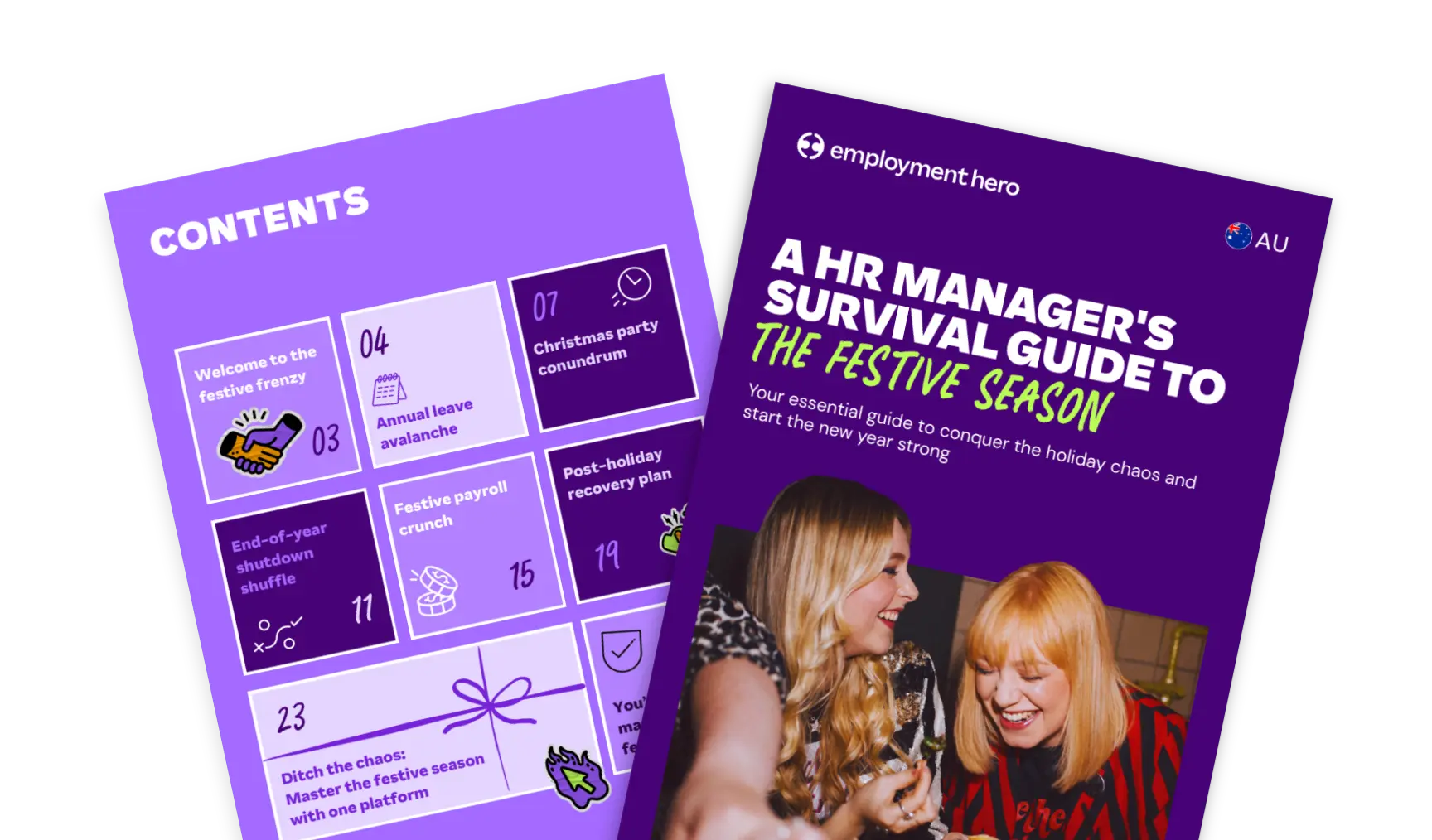30 Ways to improve workplace culture [Free Guide]
Published
30 Ways to improve workplace culture [Free Guide]
Workplace culture. It’s considered a bit of a business buzzword these days, and with good reason. But, what exactly is it and why should you consider it in your workplace? We’re unpacking all of this in our handy culture bundle.
What’s in the workplace culture bundle?
If you’re looking to improve your workplace culture, but not sure where to start – this one’s for you. We’ve put together a bundle to help you achieve a better company culture in as little as 30 days. In here, you’ll find:
- The ultimate guide to improving your workplace culture in 30 days: This guide includes 30 great ideas to improve your culture in 30 days. In this guide, you’ll find practical strategies that you can implement straight away set out in an easy to understand, visual format.
- 30-day culture calendar: This calendar maps out the strategies shared in the guide to have you achieving better workplace culture in 30 days.
- Employee wellness survey template: Supporting physical and mental health in the workplace is crucial to creating a positive company culture. This template will help you identify areas for improvement.
- Employee happiness survey template: Do you know how happy your employees really are? A simple survey can help you identify and improve your employee happiness score.
Download our workplace culture bundle now.
What is workplace culture?
Workplace culture can be described as the personality of your workplace. It combines your company values, beliefs, behaviors, and attitudes of your employees.
First and foremost, it’s important to note that developing a positive workplace culture requires work.
To provide a baseline, expectations can be set out in company policies that everyone has to comply with. Additionally, workplace culture stems from the attitude of your team, workplace processes, management style, and day-to-day activities.
What are the benefits of having a positive workplace culture?
When it comes to work, everyone is searching for a role and workplace they love going to everyday. They look forward to the work they are doing, the contribution the organisation is making to society and the people they’re surrounded by. When your team enjoys all of these things, they’re more likely to be more engaged and innovative in their roles, which can do wonders for your workplace culture and business.
But the benefits go beyond that. Having a positive work environment and a good company culture also increases revenue. Did you know that having a good company culture increases revenue up 4x? With returns like these, it’s time to take improving your company culture seriously.
In addition to the direct benefits to the company, a strong company culture can also have a positive impact on the employees themselves. It promotes positive mental health and well-being, reduces stress, and enhances job satisfaction. And when employees feel good about their work and their workplace, it has a ripple effect on their personal lives, leading to greater happiness and overall well-being.
This is why prioritising company values and fostering a positive organisational culture is not just good for business; it’s also the right thing to do for your people.

What happens if you don’t address workplace culture?
Ignoring your workplace culture can be detrimental to your business.
It has the potential to create a negative knock-on effect across the business, and can even lead to your team dreading coming to work. The results from this? A decrease in productivity, engagement and output, and who wants that?
Plus, as your business grows, you may find yourself dealing with increased reports of bullying or harassment, which can create a toxic workplace culture. While each organisation has a different way of dealing with these situations, adopting a strict policy and stand on these issues is important, and can make all the difference when it comes to shaping your culture.
If these reports get swept under the rug with no real consequences, they’re likely to continue to happen. This may lead to an increase in employee turnover or burnout, and a general disengagement of your team.
A toxic workplace culture doesn’t emerge overnight; it often develops gradually, with warning signs that are ignored or dismissed. These signs can include:
- Increased absenteeism and presenteeism (being physically present but not productive)
- A rise in employee complaints and grievances
- Decreased communication and collaboration among team members
- A lack of trust in leadership
- High levels of stress and anxiety among employees
- An increase in conflicts and interpersonal issues
Addressing these issues requires a proactive and comprehensive approach. It’s not enough to simply implement policies; there needs to be a genuine commitment to creating a positive work environment where everyone feels safe, respected, and valued.
This includes providing training to managers on how to handle conflict, promoting open communication, and fostering a culture of empathy and understanding. Ignoring mental health in the workplace is also a significant contributor to a toxic workplace culture.
Importantly, the impact of a toxic workplace culture extends beyond the individual employees; it can also damage the company’s reputation and make it difficult to attract and retain top talent.
Our handpicked favorites on improving workplace culture
We have the full list of the 30 ways to improve workplace culture in our free guide, but here is a taste of our favorites to get you started. Our top tips on improving workplace culture in your organisation include:
Send out a happiness survey
Do you know how happy your employees really are?
Simple employee surveys can help you understand employee satisfaction and identify areas for improvement in your organisation so you can start introducing company culture activities from day dot.
Employee surveys are a powerful tool for gathering feedback and gaining insights into the employee experience. To maximize their effectiveness, it’s important to:
- Ensure anonymity: Employees are more likely to provide honest feedback if they feel their responses are confidential.
- Keep it concise: Lengthy surveys can lead to survey fatigue and lower response rates. Focus on the most important questions.
- Ask the right questions: Design questions that are clear, specific, and relevant to the aspects of company culture you want to assess.
- Take action on the results: It’s crucial to analyse the survey data and use it to drive meaningful change. Communicate the findings to employees and let them know what steps will be taken to address their concerns.
- Make it regular: Conduct employee surveys on a regular basis to track progress and identify emerging issues.
By consistently seeking feedback and acting on it, you can demonstrate to your employees that their voices are heard and valued, which in itself is a significant step towards improving organisational culture.
Introduce 1:1’s in your organisation
1:1’s are a weekly or fortnightly meeting an employee has with their direct manager. This is time dedicated to the employee to talk through how their past week or fortnight has gone, as well as commit to tasks for the future. 1:1’s are a great way to improve communication amongst managers and their direct reports.
They’re also the cornerstone of effective management and a vital component of a healthy company culture. These meetings provide a dedicated space for managers and employees to connect, communicate, and collaborate.
To make the most of 1:1 meetings:
- Set clear expectations: Both the manager and the employee should understand the purpose of the meetings and what topics will be covered.
- Be consistent: Regular 1:1 meetings should be a priority, even when schedules are busy.
- Focus on the employee: The meeting should be primarily focused on the employee’s needs, goals, and challenges.
- Provide feedback: 1:1 meetings are an opportunity for managers to provide constructive feedback, both positive and negative.
- Listen actively: Managers should listen attentively to their employees, ask clarifying questions, and demonstrate empathy.
- Discuss career development: Use 1:1 meetings to discuss the employee’s career goals and identify opportunities for growth and development.
By prioritising regular and effective 1:1 meetings, organisations can foster stronger manager-employee relationships, improve communication, and create a more supportive and engaging work environment.
Bring your pet to work
Everyone loves a furry friend and it can do wonders for your company culture. If you’re a pet friendly office, it also improves your employee value proposition greatly on those job ads!
Pet-friendly policies can be a unique and effective way to enhance company culture and create a more relaxed and enjoyable work environment. The benefits of allowing pets in the workplace include:
- Reduced stress: Studies have shown that interacting with animals can lower stress levels and improve mood.
- Increased social interaction: Pets can act as icebreakers and encourage employees to interact with each other.
- Improved morale: The presence of pets can create a more positive and uplifting atmosphere.
- Enhanced creativity: A more relaxed and happy work environment can stimulate creativity and innovation.
However, it’s important to implement pet-friendly policies carefully to ensure a safe and productive environment for everyone. This includes:
- Establishing clear guidelines: Set rules for pet behavior, hygiene, and designated areas.
- Considering allergies: Take into account employees who may have allergies or phobias related to animals.
- Ensuring safety: Prioritise the safety of both employees and animals.
- Gaining employee input: Before implementing pet-friendly policies, gather feedback from employees to address any concerns or suggestions.
Download our pets in the workplace policy template here.
Organise bi-weekly all-hands meetings
An all-hands meeting is a company wide meeting that provides a general overview of how the company is going. It’s a time for teams to share their wins and updates moving forward.
It provides transparency and improves company culture as the entire team can celebrate wins together. Communication is key to a strong company culture, so introducing a company all-hands is a great way to learn more about general company updates.
To make all-hands meetings effective:
- Set a clear agenda: Define the purpose of the meeting and create a structured agenda to ensure that all important topics are covered.
- Communicate regularly: Hold all-hands meetings on a consistent schedule to provide regular updates and maintain transparency.
- Encourage participation: Create opportunities for employees to ask questions, provide feedback, and share their ideas.
- Celebrate successes: Use all-hands meetings to recognise and celebrate both individual and team accomplishments.
- Reinforce core values: Use the platform to reiterate the company’s core values and how they guide the organization’s decisions and actions.
- Keep it engaging: Incorporate interactive elements, such as polls, Q&A sessions, or presentations from different departments, to keep employees engaged.
By conducting regular and well-structured all-hands meetings, companies can foster a culture of transparency, communication, and shared purpose, which are essential for a positive organisational culture.
Consider days off for birthdays
While celebrating your birthday at work can be fun, why not investigate providing an extra day of annual leave for their special day?
Giving 21 days of annual leave is also a great way to improve your employee value proposition and attract top talent.
Offering employees a day off for their birthday is a simple yet impactful way to show appreciation and support their well-being. This gesture demonstrates that the company values its employees as individuals and recognizes the importance of personal time.
The benefits of this policy include:
- Increased employee morale: It makes employees feel valued and appreciated.
- Improved work-life balance: It allows employees to celebrate their special day without work-related stress.
- Enhanced employer branding: It shows you’re employee-centric.
- Boosted employee retention: It contributes to a positive work environment where employees feel valued and are more likely to stay in the business longer.
When implementing this policy, it’s important to:
- Be flexible: Allow employees to choose a day within their birthday week if their actual birthday doesn’t suit them.
- Communicate clearly: Ensure that the policy is clearly outlined in the employee handbook and communicated to all staff.
- Celebrate birthdays: Even with the day off, acknowledge and celebrate employees’ birthdays in the workplace to foster a sense of community.
Recognise top team players
Reward and recognition is an integral part of creating a positive workplace culture, not to mention all of the benefits that come attached to it.
Learn how to create a recognition rich culture with our reward and recognition guide.
Employee recognition is a powerful motivator and a key driver of a positive company culture. When employees feel appreciated for their contributions, they’re more likely to be engaged, productive, and committed to the business goals.
Effective employee recognition programs should:
- Be timely: Recognition should be given promptly after the achievement or contribution.
- Be specific: Clearly state what the employee is being recognised for.
- Be sincere: Recognition should be genuine and heartfelt.
- Be varied: Offer different forms of recognition to cater to individual preferences.
- Be inclusive: Ensure that all employees have the opportunity to be recognised.
There’s never been a better time to invest in your workplace culture
Get the complete list of 30 ways to improve workplace culture with our guide.
Download our workplace culture bundle now.
Looking for more resources?
Here are some helpful resources to help your company improve workplace culture:

To download the bundle, we just need a few quick details:
Related Resources
-
 Read more: HR Managers: Don’t just survive the festive season, master it
Read more: HR Managers: Don’t just survive the festive season, master itHR Managers: Don’t just survive the festive season, master it
Make year-end easier: manage leave, payroll, parties and shutdowns with confidence. Get practical tips for Australian SMEs. Download the free…
-
 Read more: Preparing for 2026: Your Compliance Checklist
Read more: Preparing for 2026: Your Compliance ChecklistPreparing for 2026: Your Compliance Checklist
Get your business ready for the 1 July 2026 changes. See practical steps for Payday Super, cash flow planning and…
-
 Read more: Monthly business budget template for employers
Read more: Monthly business budget template for employersMonthly business budget template for employers
Plan your monthly income and expenses with our free monthly business budget template. Download today to track cash flow and…























